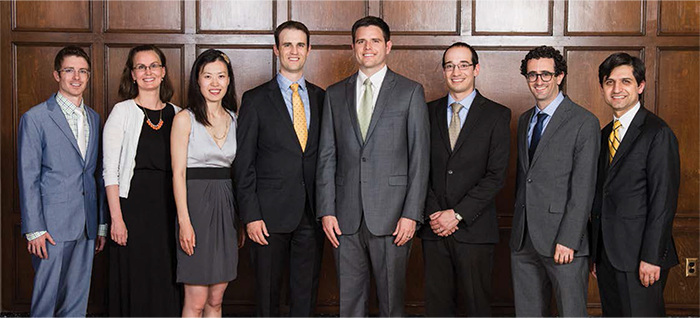Welcome to ophthalmology, class of 2020. As a program director, my goal is to help residents become successful surgeons. Building cataract surgical skills can be challenging and stressful due to a steep learning curve — and high stakes for the patient. Both the local anesthesia and instrumentation for microsurgery can make it challenging for faculty to provide real-time feedback. In addition, most residents have limited exposure to microsurgery in medical school, which can create additional stress. Fortunately, you can take several steps before surgery to prepare for the best possible outcome. Here are a few pearls that can aid in early skill development.
1. Know your instruments
Before you start surgical cases, you should thoroughly familiarize yourself with all indications, steps and complications, as well as the instruments you’ll need. The Academy’s Basic and Clinical Science Course™ (BCSC®) books provide a concise list of instruments for many common surgical procedures. The Coursera platform also offers a useful, multiweek, online cataract surgery course. Each of the four units includes five to seven short video lectures plus a quiz. The course takes approximately two to three hours per week over four weeks to complete. Lecture videos cover both medical knowledge and skills. You can enroll yourself in the course, but many programs also enroll residents and monitor progress through official reports.
2. Get comfortable with the microscope and foot pedals
Practice sitting at the microscope and get comfortable with the positioning for both the microscope and stretcher. Also experiment with the foot pedals of the microscope and phacoemulsification unit until you’re familiar with the basic process of operating them. Knowing how to turn the microscope on, focus and adjust magnification with the pedal will certainly reduce anxiety when learning how to perform surgical steps. Having good foot-position control over irrigation, aspiration and phacoemulsification will also give you a smoother transition to surgery.
3. Spend time in the wet lab
The wet lab provides a great opportunity to become familiar with instruments and get a feel for the tissue. Practice making incisions and suturing several times. Although web labs commonly use human and porcine eyes, you can also choose from a broad array of physical simulators that let you focus on essentially every step of cataract surgery.
- The Phillips eye studio globes provide excellent simulation for capsulorhexis. You can also use them for phacoemulsification.
- The Kitaro lab eye model also has similar benefits for simulation. You can also use it to suturing.
4. Practice with virtual simulators
If your training program has access to a virtual simulator (for example, the Eyesi made by VRmagic), be sure to take advantage of the system. You can use the Eyesi to develop basic microsurgical motor skills and hand-eye coordination and practice nearly all steps of cataract and retina surgical procedures. Cataract virtual simulators can also help you both improve performance on surgical steps like the capsulorhexis and reduce surgical time and complication rates. In addition, the number of hours spent on the simulator correlates with outcomes.
5. Use your mentors
Surgical training has a strong component of preceptorship, whereby mentors aid in a progressive model of surgical competency. Even the wet laboratory curriculum must include supervised practice with senior residents and faculty mentors. Make sure to have regular discussions and operating-room exposure with faculty. This will help you develop a meaningful mentoring relationship and learn the most you can from more experienced surgeons.
6. Watch surgical videos
Videos provide another great way to become familiar with surgical cases, whether you’re assisting or serving as primary surgeon. You can watch videos on the Academy’s Ophthalmic News and Education (ONE®) Network or view previous cases of your surgical faculty.
7. Record and review your own surgeries
Once you begin performing your own procedures, good surgical practice habits include recording all cases and reviewing them with other residents and/or faculty mentors.
You will soon learn that there are unique challenges associated with developing surgical skills in all subspecialties of ophthalmology. I wish the class of 2020 great success.

From L-R: Michigan Medicine Kellogg Eye Center Class of 2016, Stephen Smith, MD; Michelle Kron-Gray, MD; Grace Wang, MD; Kevin Tozer, MD; David De Mill, MD; Max Stem, MD; Neil Farbman, MD; and Shahzad I. Mian, MD.
* * *
 About the author: Shahzad I. Mian, MD, is a professor of ophthalmology and visual sciences at the University of Michigan Kellogg Eye Center and holds the Terry J. Bergstrom Collegiate Professorship for Resident Education. He has been director of the residency training program since 2004 and serves as the associate chair for education. He is also the 2017 president of the Program Director’s Council of the Association of University Professors of Ophthalmology.
About the author: Shahzad I. Mian, MD, is a professor of ophthalmology and visual sciences at the University of Michigan Kellogg Eye Center and holds the Terry J. Bergstrom Collegiate Professorship for Resident Education. He has been director of the residency training program since 2004 and serves as the associate chair for education. He is also the 2017 president of the Program Director’s Council of the Association of University Professors of Ophthalmology.